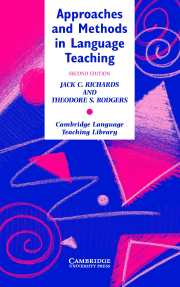Book contents
- Frontmatter
- Contents
- Preface
- Part I Major language trends in twentieth-century language teaching
- 1 A brief history of language teaching
- 2 The nature of approaches and methods in language teaching
- 3 The Oral Approach and Situational Language Teaching
- 4 The Audiolingual Method
- Part II Alternative approaches and methods
- Part III Current communicative approaches
- Author index
- Subject index
2 - The nature of approaches and methods in language teaching
Published online by Cambridge University Press: 06 July 2010
- Frontmatter
- Contents
- Preface
- Part I Major language trends in twentieth-century language teaching
- 1 A brief history of language teaching
- 2 The nature of approaches and methods in language teaching
- 3 The Oral Approach and Situational Language Teaching
- 4 The Audiolingual Method
- Part II Alternative approaches and methods
- Part III Current communicative approaches
- Author index
- Subject index
Summary
We saw in the preceding chapter that the changing rationale for foreign language study and the classroom techniques and procedures used to teach languages have reflected responses to a variety of historical issues and circumstances. Tradition was for many years the guiding principle. The Grammar-Translation Method reflected a time-honored and scholarly view of language and language study. At times, the practical realities of the classroom determined both goals and procedures, as with the determination of reading as the goal in American schools and colleges in the late 1920s. At other times, theories derived from linguistics, psychology, or a mixture of both were used to develop a both philosophical and practical basis for language teaching, as with the various reformist proposals of the nineteenth century. As the study of teaching methods and procedures in language teaching assumed a more central role within applied linguistics from the 1940s on, various attempts have been made to conceptualize the nature of methods and to explore more systematically the relationship between theory and practice within a method. In this chapter we will clarify the relationship between approach and method and present a model for the description, analysis, and comparison of methods.
Approach and method
When linguists and language specialists sought to improve the quality of language teaching in the late nineteenth century, they often did so by referring to general principles and theories concerning how languages are learned, how knowledge of language is represented and organized in memory, or how language itself is structured.
- Type
- Chapter
- Information
- Approaches and Methods in Language Teaching , pp. 18 - 35Publisher: Cambridge University PressPrint publication year: 2001
- 1
- Cited by



